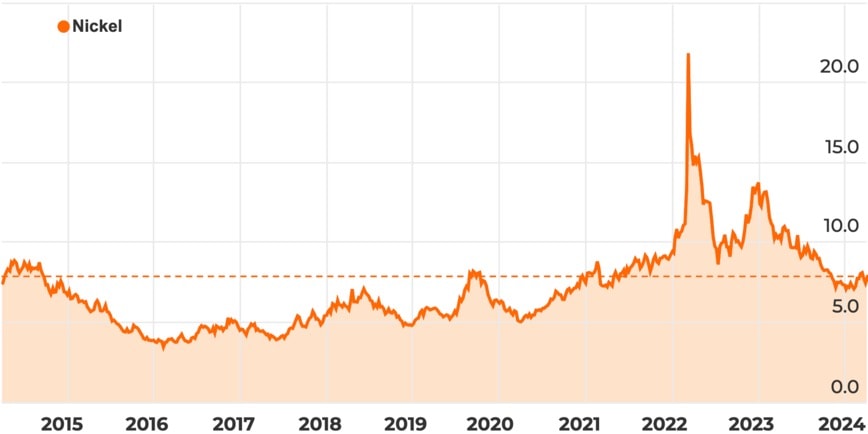Nickel market faces surplus as Indonesia and Philippines boost output

Some call nickel the “devil’s metal” because of its history of dramatic booms and busts.
Right now, it is more about the devilry being caused by major producing nations that is probably the biggest concern.
Numerous reports have emanated in recent weeks that Indonesia – the world’s leading nickel producer – intends to ramp up its output, supposedly to further damage an already struggling market and hit rival producers like Australia while they are down.
Australia’s Resource Minister Madeleine King recently stated that the crash of the global nickel price and its impact on Australian projects could be tied back to “many billions of dollars of investment, principally from China, into the Indonesian nickel industry.”
Global nickel surplus
According to the Office of Australia’s Chief Economist, the strong supply growth in recent years — predominantly from Indonesia and China — has created a global nickel surplus that is expected to persist over the next few years.
This surplus has put sustained downward pressure on the nickel price over the past year, leading to a fall of 40% in the 12 months to February 2024.
Indonesia is estimated to have added more than 450,000 tonnes of new nickel output in 2023, the equivalent of 14% of total global supply in the previous calendar year.
With an estimated 21Mt, or 20.6% of the world’s nickel reserves, Indonesia is in a strong position to continue to influence global production and prices.
The rapidly-growing Asian shift from fossil fuels like coal into battery metals like nickel has led to a recent surge of large Indonesian coal miners moving into the nickel market.
Minister King has raised concerns about the lesser environmental, social and governance considerations attached to some international mining operations in comparison to the tough legislation enacted in Australia and suggested nickel pricing should reflect the “cleaner, greener” efforts of local producers.
Her feelings have reportedly been backed up by Australian mining executive Andrew Forrest, who suggested China should seek higher environmental standards from its global supply chain, particularly its companies conducting nickel processing in Indonesia.
In a media interview, Mr Forrest suggested electric vehicle manufacturers should be wary of Indonesian nickel, adding that it was being extracted at immense cost to the environment.
Philippines fightback
In the Philippines – the world’s second largest nickel producer – there are growing reports of local activists protesting the expansion of mining in the country.
With massive reserves, cheap labour and significant export earning potential in the global battery metals market, the Philippines government is showing strong support for its local nickel producers.
Backed by the Philippines’ all-powerful Catholic church, however, locals in some areas are becoming extremely vocal about the effects they say the growing mining activity is having on the local environment.
Numerous blockades and threats to mines have been recorded across the southeast Asian nation.
Australian weakness
Australian producers are also watching the sudden expansion of Philippine and Indonesian nickel mining activity in a market that is already in surplus.
The Australian Department of Industry, Science and Resource’s (DISR) latest resources and energy quarterly report found that current weaker prices and reduced production are expected to see Australian nickel export earnings fall to $3.6 billion in 2023–24 and $2.5b in 2024–25.
This is largely due to the dramatic decline in global nickel prices—and those are not expected to improve any time soon.

The DISR tips the London Metals Exchange nickel price to average US$17,000 a tonne in 2024 and to less than $18,000/t through to 2026.
However, it says the continued growth in clean energy applications should see a more balanced market from 2027 with prices projected to recover to around US$19,000/t by 2029.
The DISR is tipping Australian production will grow as prices improve.
It says the higher prices projected from late 2026 will support higher production volumes, with a number of projects set to come online in coming years.
Australian mined nickel production is then projected to grow to 230,000t in 2028–29, with new output from a number of large and mid-tier producers.
